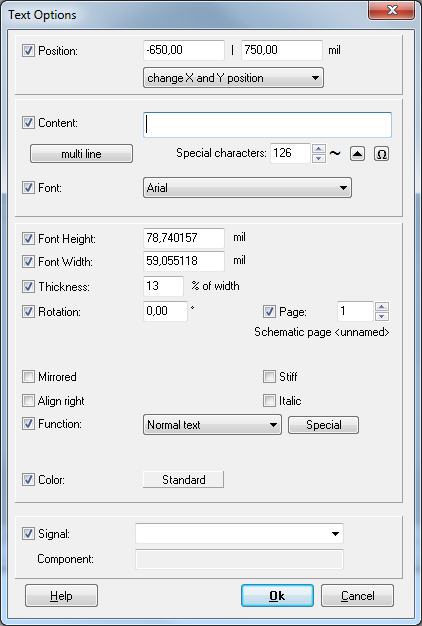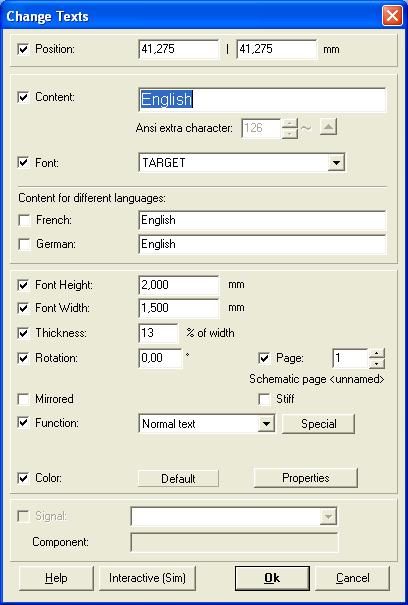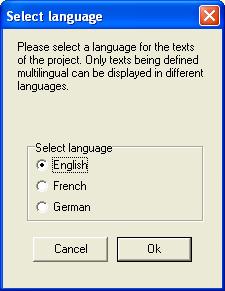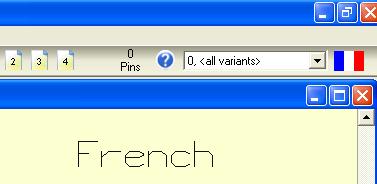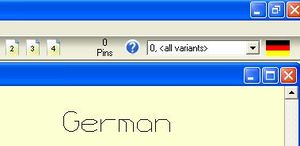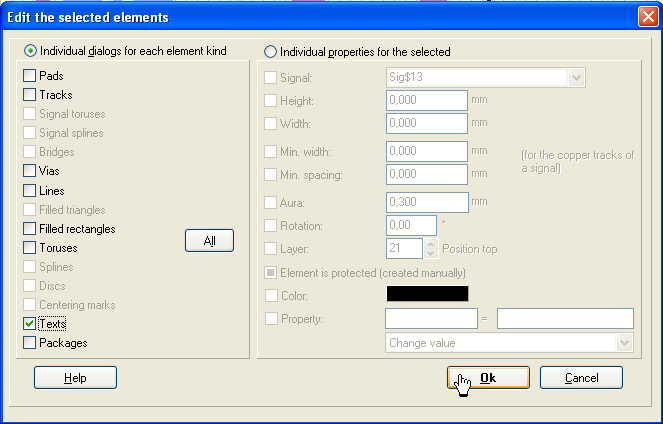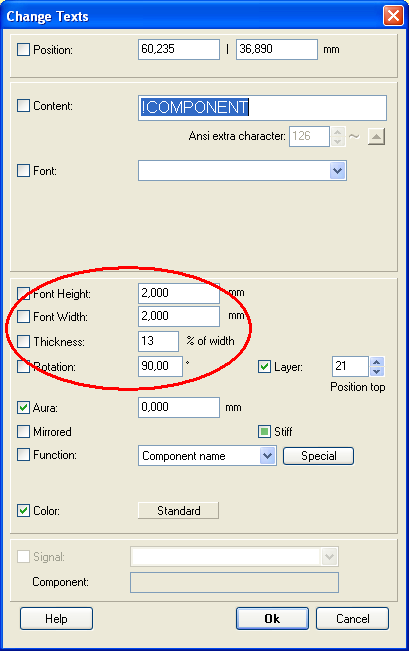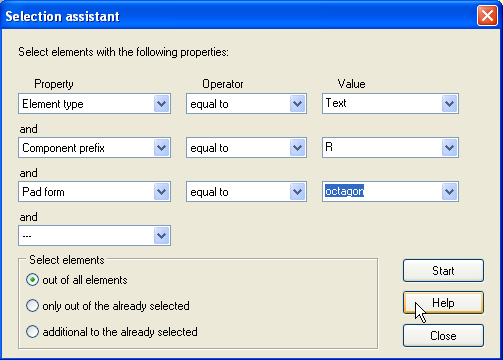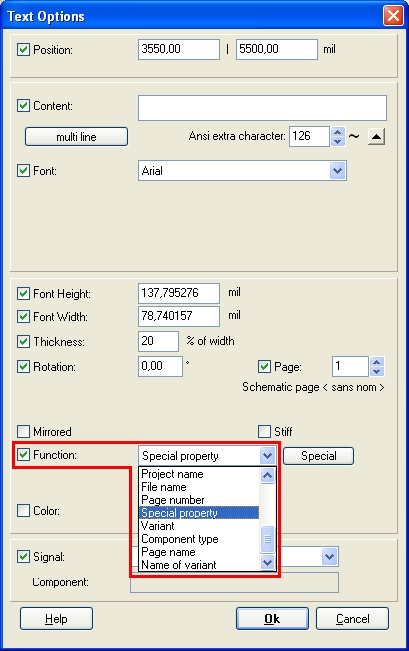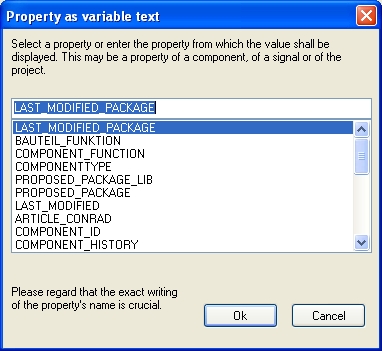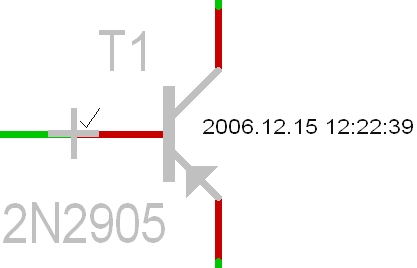Text
Contents
General
You can reach this mode...
by ["] or
by"Text" in menu "Elements" or
by the tool ![]() subsumed under the "pencil" icon (the drawing functions).
subsumed under the "pencil" icon (the drawing functions).
What you can do...
Click M1 to where the text later shall appear. Enter the text and its options to the following dialog. Close the dialog with OK to place the text. Caution: Win 95/98/ME have an old 16-bit graphic, which is not able to mirror Windows fonts. Only the font TARGET can be mirrored in Win 95/98/ME. The Windows fonts can only be mirrored by the 32-bit graphic of Win NT4/2000/XP/Vista.
The TARGET 3001! Gerber driver is not able to output Windows fonts. They are replaced by the TARGET 3001! font. Always check the result of this replacement!
Leave this mode...
by [ESC] or M1
Elements of the Text dialog
Position: defines the exact location of the text.
Content: allows the entering of your text fragments.
Font: Choose any Windows font or "extra ANSI characters". Browse the ANSI characters before bringing them to your text by the use of the "arrow up" button. Additionally the font "TARGET" exists, which is used when external export drivers (e.g. GERBER) are chosen. Regard that Gerber can only output the TARGET font and that only Windows NT is capable of mirroring Windows fonts. So in the schematic you normally can use any font you like, however be cautious to use Windows fonts in thePCB layout.
Font Height and Width: define the average measurements of the fonts. The Windows fonts can deviate from this defaults.
When zooming out text at a sudden point can only be displayed as black box. This question of resolution can be controled in the "Settings / Options" dialog entering a lower value to the "Minimum width" field.
Thickness: applies only if using TARGET font. Windows fonts automatically switch from normal to bold between 10% and 20%.
Rotation: When mirroring or rotating texts by any direction or angle, they are adjusted in the way that you can always read them in normal view or in view from the right side. This rule is ignored if you tick Stiff. The text rotates fixed, according to the angle.
Page: Which schematic page the text shall appear on.
Layer: Which layer the text shall appear on.
Function: When selecting something different to normal text, then the content is adjusted to the text function you assigned. These text functions are useful e.g. for components, signals or for sheet frames and are something like variables. Important selections are:
Component name for the component type name (e.g. IC17, R15)
Component value (e.g. 4040, 4k7)
Symbol name for the name of a symbol (e.g. IC17A)
Signal name for the name of a signal (e.g. GND, Sig$13)
Pin name for the name of a connection in the schematic (z.B. RES\, Pin8)
"Package, Part number, Manufacturer/Vendor, Order number, Price" is related to the components and is used to generate a bill of material (B.O.M).
Changes in Component names, Component values and Symbol names always refer to the complete component and are annotated back and forth between schematic and layout. The same with Signal names and Signals.
Several name exchanges:
The contents of the following names will be exchanged on the screen when displayed:
!FILE: with the file name (for example: TEST.T3001)
!SCALING: with the output scaling factor (for example: 200%)
!C-DATE: Date of the last change of the file (for example: TT.MM.JJJJ)
!C-TIME: Time of the last change of the file (for example: HH:MMh)
!P-DATUM: Actual date of the output (for example: TT.MM.JJJJ)
!P-TIME: Actual time of the output (for example: HH:MMh)
!PAGE: Current schematic page
Multilingual text within one project
All documentations and text fragments can be edited in three languages, let's say in English, German and in French. After you have placed a lettering in English language (for example the word "English"),
click in schematic or layout double on the text. The following dialog opens:
In section
tick the boxes for further languages which you'd like to use and write the text into the lines. For demonstrational reasons we have used the words "French" and "German". If you enter OK, you first see only the English lettering. This is, because you are in the English documentation of the project. Please note the English/American flag on screen.
If you click on the flag, the following dialog appears:
Click on a radiobutton to see the letterings in a different language. Viewing the flag, you see which language version you currently work with:
Text can be edited in three languages simultaneously. Which kind of language you use don't matter.
Important note: Multilingual text within one project has nothing to do with "variants". It is a separate, independent text function.
.
Adjust the size of all text elements
Highlight the complete layout by the use of a Capture Window. Press keyboard key "[e]" for edit. The dialog : "Edit the selected Elements" opens.
Tick the box "Texts" and press OK. The dialog "Change Texts" opens.
Now do all desired adjustments. If you only want to change (= highlight) certain elements, please use the Selection Assistant in menu "Edit".
Example for the selection of texts of resistors having octagonal pads.
Place a component property as text close to the symbol or package
In schematic and layout all properties a component has can be placed like a text aside of the component. First activate the text mode. Hover the cursor over the handle cross of the desired component. Now press keyboard key ["] for opening the text mode dialog "Text Options". Now choose the text function: "Special property" see image (section in red)
As soon as the special property as a text function is activated, a list opens from which you can select the desired property, e.g. "Last Modified", the date of the latest modification of a part.
Then press [OK] and confirm the dialog of the "Text Option" too. See the new text in the image below on the right hand side, the LAST MODIFIED - Date. You can select this text, place it at your convenience and change the font.
Please note, that you eventually have to release this button ![]() for touching and selecting only the text. You'll find it in the Sidebar under section Settings.
for touching and selecting only the text. You'll find it in the Sidebar under section Settings.
Einen Kommentar neben ein Bauteil schreiben
Drücken Sie die Tastaturtaste [ß] um den Textdialog zu öffnen. Der Mauszeiger ändert sich und sie sind im Text-Modus.
Klicken Sie M1 an der Stelle, an der die erste Zeile des Textes beginnen soll. Der Textdialog öffnet sich. Drücken Sie den Knopf "mehrzeilig" um nun eine Textbox zu öffnen. Geben Sie hier Ihren Text ein.
Das Ergebnis könnte so aussehen:
Die viereckigen Kästchen der Leerzeilen deuten an, dass es sich um einen zusammenhängenden Text (= Mengentext) handelt. Doppelklicken Sie das Kästchen, um diese Zeile zu editieren. Sie können jede Zeile doppelklicken, um sie zu editieren.
.


